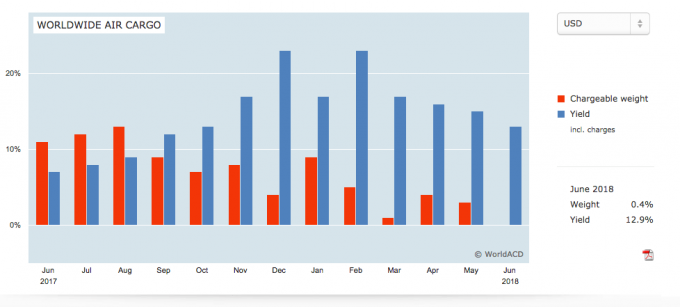No summer siesta for airfreight
Traditionally, air cargo spot rates tend to decline or remain flat at best during H1, ...

June was the first month in two years with no significant growth in air freight, according to WorldACD.
The figures are backed by Drewry’s air freight index, which showed rates fell 3% in June, month on month – although they remained up 8% year on year.
WorldACD, however, notes that the year-on-year volume increase in June was just 0.4%, although the first half overall showed growth of 3.7%.
And, it added, there is little-to-no consensus on second half prospects: will lack of capacity force rates up, or will trade policies have the opposite effect?
Acknowledging that June is not the best indicator, WorldACD nevertheless pointed out that exports from Asia-Pacific fell year on year by 0.1%.
Africa, Europe and the Middle East also fell year on year – but the Americas grew, with Latin America catching up after years of sluggish markets and the US enjoying economic growth.
The question now is how trade tariffs may affect air cargo.
WorldACD reports that Chinese air exports “dipped considerably”, by 5.9%, in June, although the market had already been performing badly: down 2.9% year on year for the first half.
And China to Europe was also negative in June, also down 2.9% year on year, while US to Europe was up 3.7% and to China up 3%.
According to analysis by Seabury, air freighted commodities such as semiconductors, cherries, lobsters and cosmetics are likely to be affected by the tariffs. It calculated that cherries alone accounted for 200 full freighter flights each year.
But not all analysts agree on the effect on air cargo.
One consultant told The Loadstar that, as US cherries tended to be backhaul traffic, the impact may not be as severe. He added that there was a likelihood that countries such as South Korea could import cheaper US cherries and re-export them to China. He also pointed out that the lobster market was mostly centred in Canada, which could simply export the seafood directly.
Either way, the impact will be hard to determine before it bites. WorldACD notes.
“To us, the world of air cargo looks fairly uncertain at the moment. For once, to predict the future it may be just as helpful to read tea leaves (as well as tweets?) or to gaze into a crystal ball.”
Drewry agreed: “Airfreight rates fell 3% between May and June 2018, with Drewry’s East-West Airfreight Price Index dropping to $2.63 per kg… The ramifications of the trade war between the US and China, as well as tariffs on the EU and Canada, make it hard to predict the market.”
Further information on yields, from WorldACD, is here.
Comment on this article